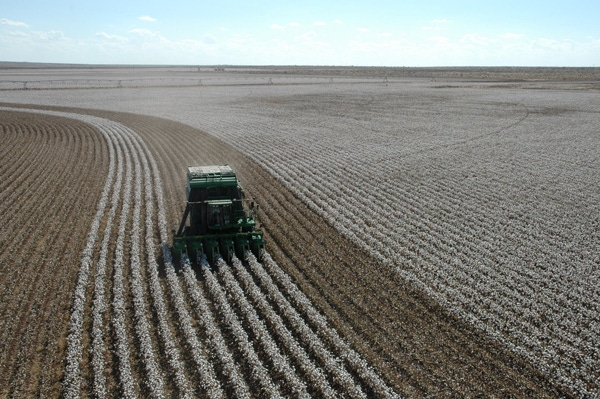
USDA’s August crop estimates, which indicated an increase in U.S. cotton production from July, may not fully account for the extraordinary environmental forces at work in Texas and other states.A lot of west Texas irrigated cotton is reportedly cutting out a lot earlier than normal, which could lead to an even smaller crop.Losses in Texas could be offset by production gains in the Delta and Southeast, where yields and production could benefit by an open fall.

Quite a few market analysts were puzzled by USDA’s Aug. 11 crop report, which projected a hefty 550,000-bale increase in U.S. cotton production, despite a Texas crop which appears to have been severely compromised by record drought and heat this season.
So what’s up?
Extension economist John Robinson, speaking at the August Ag Market Network conference call, was as surprised as anyone by the revision in the production number. Based on what he’s seen in Texas, he looks for USDA’s estimate of the cotton crop to stay the same or get smaller as the season progresses “depending on whether increases in the eastern part of the United States offset further decreases in the Southwest.”
Robinson says USDA’s August cotton numbers, the first estimates based on actual field sampling, may not fully account for the extraordinary environmental forces at work in Texas and other states.
Well over half of Texas cotton acres planted this season will be abandoned, according to USDA. USDA is projecting that 4.5 million bales will be produced in Texas on 3.4 million acres, compared to 7.87 million bales last year on 5.4 million acres. This year’s average yield is projected at 636 pounds, 68 pounds under last year.
In its statistical models, USDA assumes normal weather for the season but also considers crop maturity against average frost dates. But this has been anything but a normal season for U.S. cotton producers, especially for those in Texas.
Robinson noted that a lot of west Texas irrigated cotton is reportedly cutting out a lot earlier than normal. “What normally would be happening in September, like irrigation termination, is happening now. This suggests to me that this is not a normal year in terms of yield potential. It suggests to me that the crop is running out of time. If the USDA models don’t account for some of that external information, I can see them overestimating yield.
“This does set us up for a surprise when they go out and measure in September. If there is a further change in the downside, I see it coming from west Texas related to the irrigated crop.”
The lateness of the crop in the Delta and Southeast is also a concern for Robinson. “Those crops got off to a late start. There was replanting in Georgia, rain and flood delays in the Delta. Those crops are doing better, but just the fact that those crops are late sets us up for more uncertainty. First of all, you need timely rain until the end of the growing season. You also need clear open weather for maturation in September and October.
“Will the Delta and Southeast get the weather they need to really mature a big crop, or will they come out with something smaller? Will there be more bales from that part of the world to offset more losses than we’re seeing from the Southwest? Those are questions that may not be resolved until the September, October and November reports. What it means is more than the usual amount of supply uncertainty. And it’s going to put more importance on the September, October and November USDA reports.”
Robinson noted that during drought years, USDA often revises production downward from the August report. “The adjustments have ranged from 2 percent to 10 percent lower. From 2004-2008, we tended to have an increase in production from the August estimates. In 2008, the final number was 15 percent higher. That’s the biggest historical percent change in either direction from an initial August number.
“On average, the percent change in any direction from the initial August estimate is around 8 percent. Right now, we’re working with an estimate of 16.5 million bales. A 10 percent adjustment is around 1.7 million bales, which would give us a crop of just under 15 million bales.”
Robinson says the supply uncertainty in the United States may not really matter all that much for price. USDA reduced foreign cotton production by about 1 million bales and decreased foreign consumption by about 1.5 million bales, with China accounting for a third, India a third and Pakistan, Turkey and Mexico for the rest.
The result was a slightly higher world ending stocks number, 52.66 million bales, than last year’s 51 million bales.
U.S. cotton could be slipping back into a role of residual supplier, according to Robinson. “If our production drops, exports will be adjusted accordingly, and the bottom line ending stocks remain in the neighborhood of where they are now. So I don’t think the world balance sheet is going to change much.
“We’re in an uncertain picture,” Robinson said. “It’s going to take time for things to unfold.”
About the Author(s)
You May Also Like





